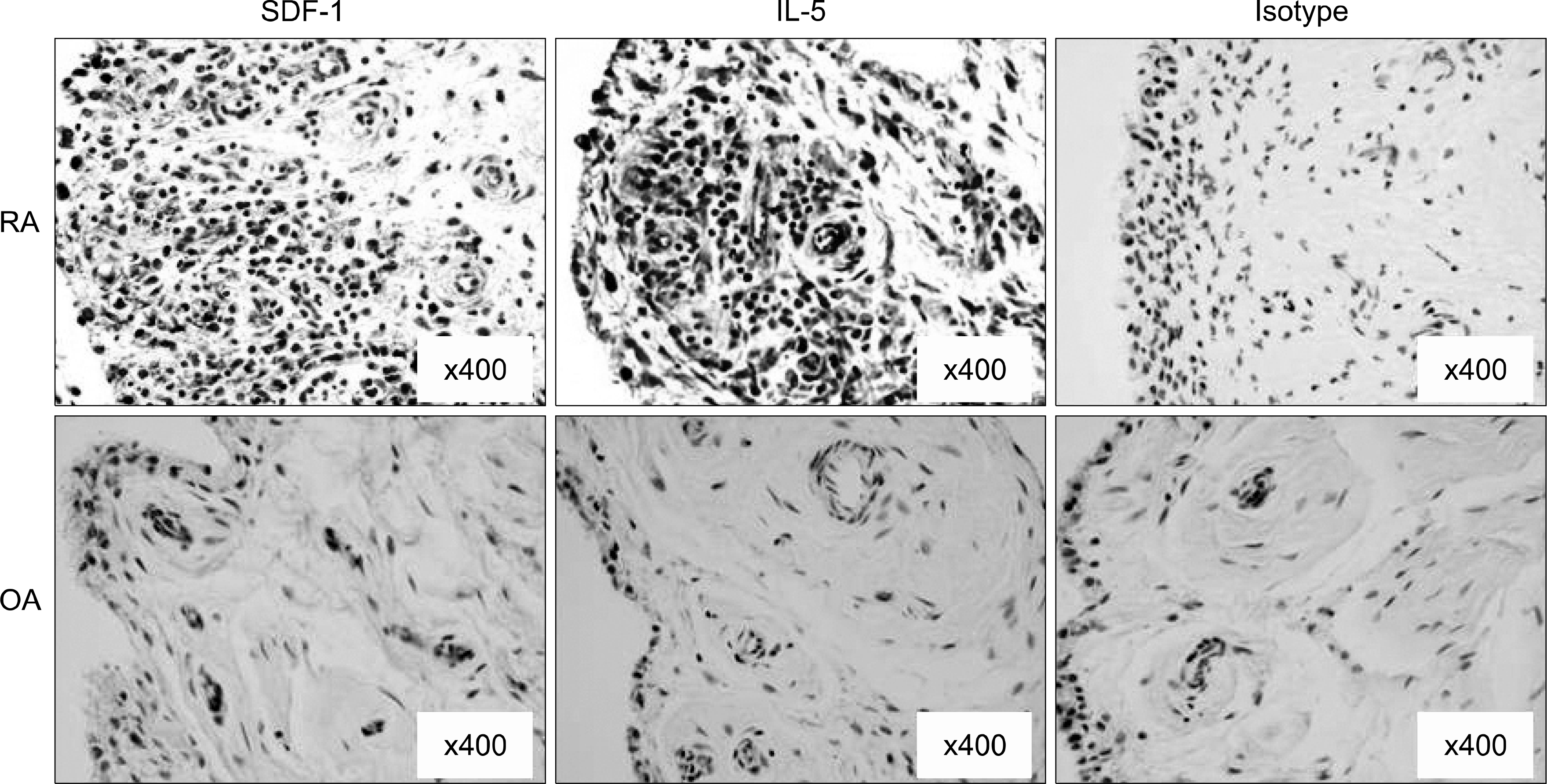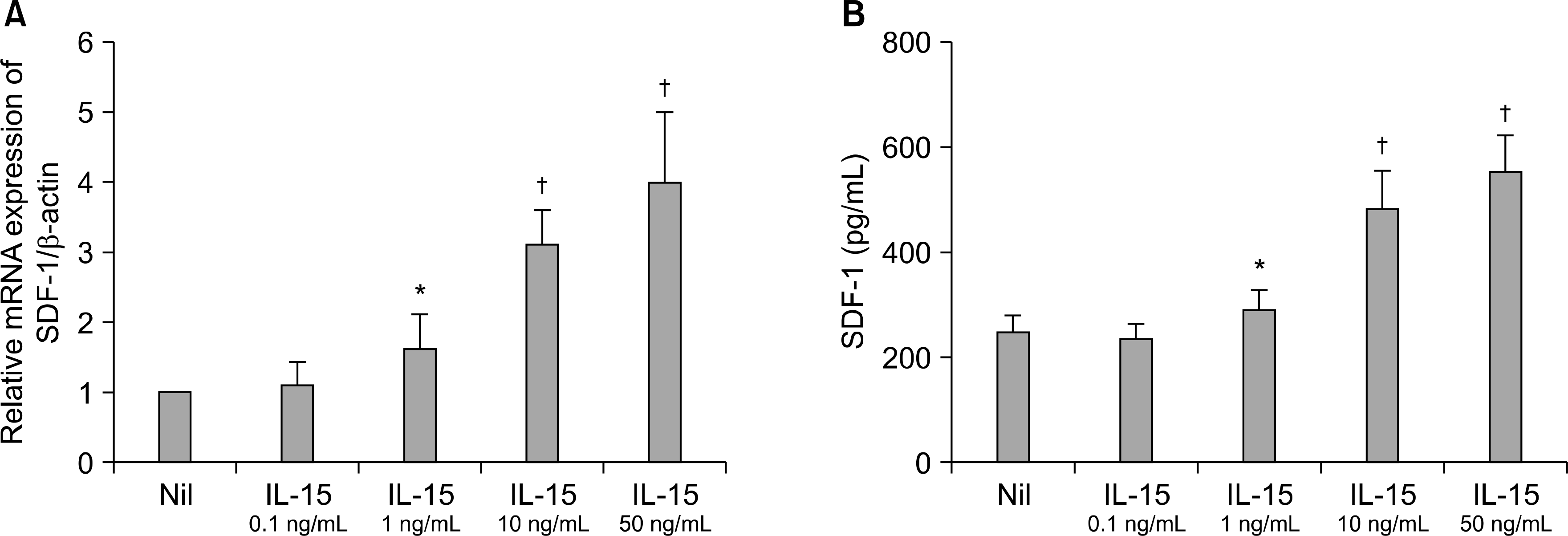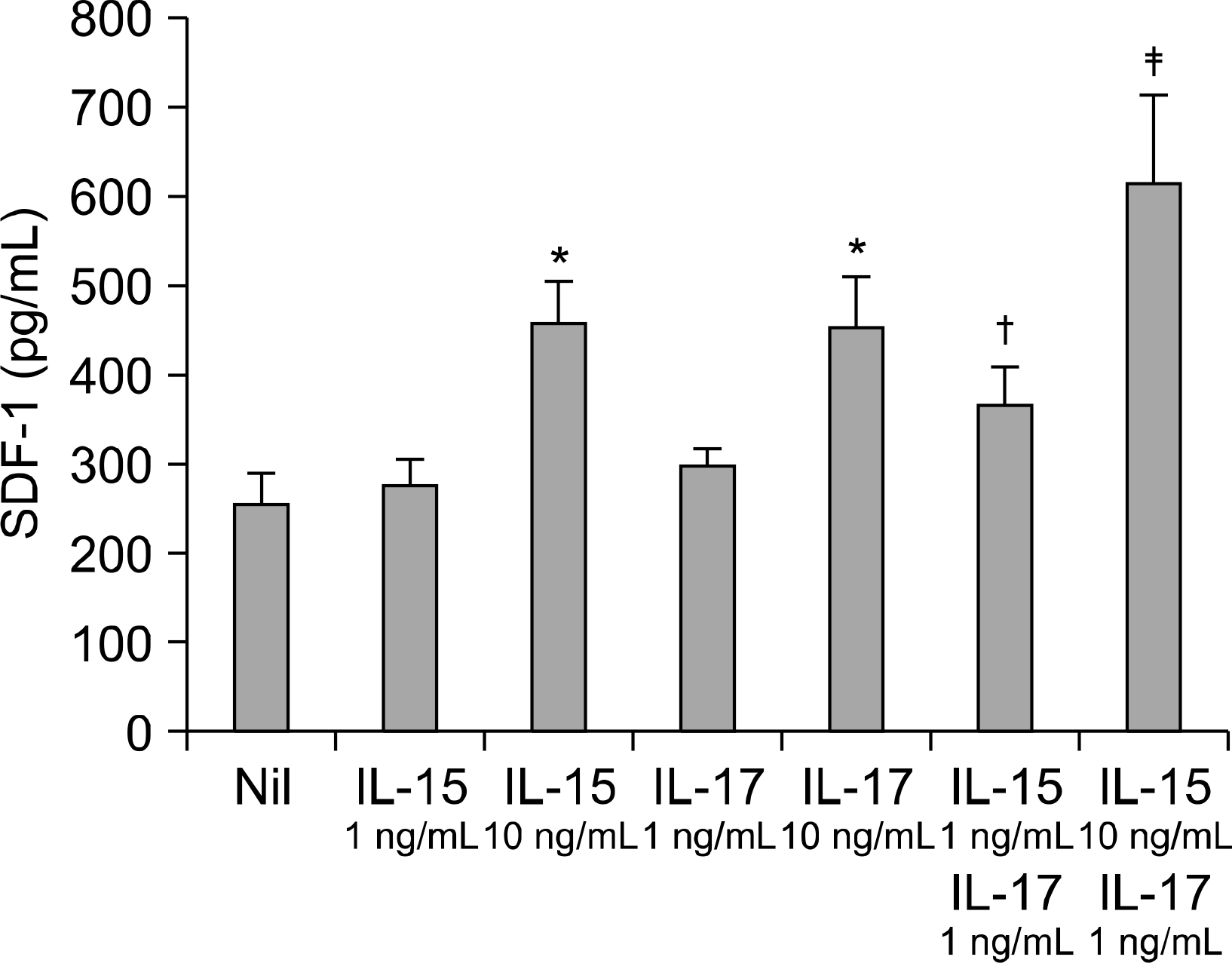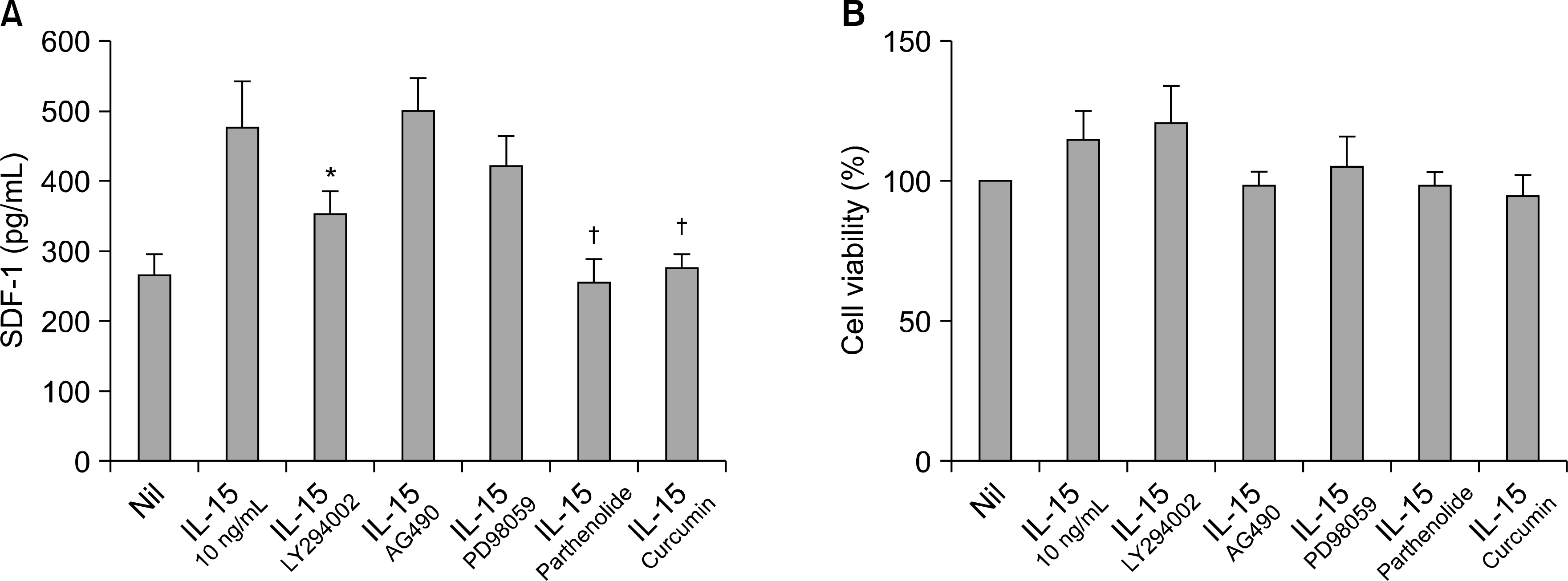Abstract
Objecti
Interleukin-15 (IL-15) recruits and activates synovial T cells, and IL-15 plays an important role in amplifying and perpetuating inflammation in the pathogenesis of rheumatoid arthritis (RA). Stromal cell-derived factor-1 (SDF-1) is a potent chemoattractant for memory T cells in the inflamed RA synovium. This study investigated the effect of IL-15 on SDF-1 production in RA fibroblast-like synoviocytes (FLS).
Methods
The expressions of IL-15 and SDF-1 were determined from the synovium of patients with RA and osteoarthritis (OA) by performing immunohistochemistry. The expressions of SDF-1 was measured from the RA FLS that were cultured with IL-15 and IL-17 by real-time RT-PCR and ELISA. The SDF-1 expression was also measured, via ELISA, from the RA FLS stimulated by IL-15 together with the inhibitors of such intracellular signal molecules as phosphatidylinositol 3-kinase (PI 3-kinase, LY294002), STAT3 (AG490), MAP Kinase (PD98059), NF-κB (parthenolide) and activator protein 1 (AP-1, curcumin).
Results
IL-15 and SDF-1 were mainly expressed in the RA synovium compared to that of the OA synovium. IL-15 increased the SDF-1 expressions and it, and had an additive effect with IL-17 on the SDF-1 expressions in the cultured RA FLS. The IL-15 induced increase of the SDF-1 expression in the cultured RA FLS was blocked by the inhibitors of PI 3-kinase, NF-κB and AP-1.
REFERENCES
1). MuUller-Ladner U., Pap T., Gay RE., Neidhart M., Gay S. Mechanisms of disease: the molecular and cellular basis of joint destruction in rheumatoid arthritis. Nat Clin Pract Rheumatol. 2005. 1:102–10.
2). Mittal GA., Joshi VR., Deshpande A. Stromal cell-derived factor-1 alpha in rheumatoid arthritis. Rheumatology (Oxford). 2003. 42:915–6.
3). Kanbe K., Takagishi K., Chen Q. Stimulation of matrix metalloprotease 3 release from human chondrocytes by the interaction of stromal cell-derived factor 1 and CXC chemokine receptor 4. Arthritis Rheum. 2002. 46:130–7.

4). Grassi F., Cristino S., Toneguzzi S., Piacentini A., Facchini A., Lisignoli G. CXCL12 chemokine up-regulates bone resorption and MMP-9 release by human osteoclasts: CXCL12 levels are increased in synovial and bone tissue of rheumatoid arthritis patients. J Cell Physiol. 2004. 199:244–51.

5). Pablos JL., Santiago B., Galindo M., Torres C., Brehmer MT., Blanco FJ, et al. Synoviocyte-derived CXCL12 is displayed on endothelium and induces angiogenesis in rheumatoid arthritis. J Immunol. 2003. 170:2147–52.

6). Nanki T., Hayashida K., El-Gabalawy HS., Suson S., Shi K., Girschick HJ, et al. Stromal cell-derived factor-1-CXC chemokine receptor 4 interactions play a central role in CD4+ T cell accumulation in rheumatoid arthritis synovium. J Immunol. 2000. 165:6590–8.
7). De Klerck B., Geboes L., Hatse S., Kelchtermans H., Meyvis Y., Vermeire K, et al. Pro-inflammatory properties of stromal cellderived factor-1 (CXCL12) in collagen-induced arthritis. Arthritis Res Ther. 2005. 7:R1208–20.
8). Tamamura H., Fujisawa M., Hiramatsu K., Mizumoto M., Nakashima H., Yamamoto N, et al. Identification of a CXCR4 antagonist, a T140 analog, as an anti-rheumatoid arthritis agent. FEBS Lett. 2004. 569:99–104.

9). McInnes IB., al-Mughales J., Field M., Leung BP., Huang FP., Dixon R, et al. The role of interleukin-15 in T-cell migration and activation in rheumatoid arthritis. Nat Med. 1996. 2:175–82.

10). Thurkow EW., van der Heijden IM., Breedveld FC., Smeets TJ., Daha MR., Kluin PM, et al. Increased expression of IL-15 in the synovium of patients with rheumatoid arthritis compared with patients with Yersinia-induced arthritis and osteoarthritis. J Pathol. 1997. 181:444–50.
11). Oppenheimer-Marks N., Brezinschek RI., Mohamadzadeh M., Vita R., Lipsky PE. Interleukin 15 is produced by endothelial cells and increases the transendothelial migration of T cells in vitro and in the SCID mouse-human rheumatoid arthritis model in vivo. J Clin Invest. 1998. 101:1261–72.

12). Miranda-CaruAs ME., Balsa A., Benito-Miguel M., PeArez de Ayala C., MartiAn-Mola E. IL-15 and the initiation of cell contact-dependent synovial fibroblast-T lymphocyte cross-talk in rheumatoid arthritis: effect of methotrexate. J Immunol. 2004. 173:1463–76.

13). Cho ML., Yoon CH., Hwang SY., Park MK., Min SY., Lee SH, et al. Effector function of type II collagen-stimulated T cells from rheumatoid arthritis patients: cross-talk between T cells and synovial fibroblasts. Arthritis Rheum. 2004. 50:776–84.

14). Ruchatz H., Leung BP., Wei XQ., McInnes IB., Liew FY. Soluble IL-15 receptor alpha-chain administration prevents murine collagen-induced arthritis: a role for IL-15 in development of antigen-induced immunopathology. J Immunol. 1998. 160:5654–60.
15). Ferrari-Lacraz S., Zanelli E., Neuberg M., Donskoy E., Kim YS., Zheng XX, et al. Targeting IL-15 receptor-bearing cells with an antagonist mutant IL-15/Fc protein prevents disease development and progression in murine collagen-induced arthritis. J Immunol. 2004. 173:5818–26.

16). Baslund B., Tvede N., Danneskiold-Samsoe B., Larsson P., Panayi G., Petersen J, et al. Targeting interleukin-15 in patients with rheumatoid arthritis: a proof-of-concept study. Arthritis Rheum. 2005. 52:2686–92.

18). Mbemba E., Benjouad A., Saffar L., Gattegno L. Glycans and proteoglycans are involved in the interactions of human immunodeficiency virus type 1 envelope glycoprotein and of SDF-1aL with membrane ligands of CD4+ CXCR4+ cells. Virology. 1999. 265:354–64.
19). Burger JA., Kipps TJ. CXCR4: a key receptor in the cross talk between tumor cells and their microenvironment. Blood. 2006. 107:1761–7.
20). Dubois-Laforgue D., Hendel H., Caillat-Zucman S., Zagury JF., Winkler C., Boitard C, et al. A common stromal cell-derived factor-1 chemokine gene variant is associated with the early onset of type 1 diabetes. Diabetes. 2001. 50:1211–3.

21). Hitchon C., Wong K., Ma G., Reed J., Lyttle D., El-Gabalawy H. Hypoxia-induced production of stromal cell-derived factor 1 (CXCL12) and vascular endothelial growth factor by synovial fibroblasts. Arthritis Rheum. 2002. 46:2587–97.

22). Kim KW., Cho ML., Kim HR., Ju JH., Park MK., Oh HJ, et al. Up-regulation of stromal cell-derived factor 1 (CXCL12) production in rheumatoid synovial fibroblasts through interactions with T lymphocytes: role of interleukin-17 and CD40L-CD40 interaction. Arthritis Rheum. 2007. 56:1076–86.

23). Groh V., Bruhl A., El-Gabalawy H., Nelson JL., Spies T. Stimulation of T cell autoreactivity by anomalous expression of NKG2D and its MIC ligands in rheumatoid arthritis. Proc Natl Acad Sci USA. 2003. 100:9452–57.

24). Ernestam S., af Klint E., Catrina AI., Sundberg E., EngstroUm M., Klareskog L, et al. Synovial expression of IL-15 in rheumatoid arthritis is not influenced by blockade of tumour necrosis factor. Arthritis Res Ther. 2006. 8:R18.
Fig. 1.
Immunohistochemical staining for stromal-cell derived factor-1 (SDF-1) and interleukin-15 (IL-15) on the synovium of patients with rheumatoid arthritis (RA) and osteoarthritis (OA). IL-15 and SDF-1 were significantly more expressed in the RA synovium compared to that of the OA synovium (original magnification, ×400).

Fig. 2.
The expressions of SDF-1 from the RA synovial fibroblasts stimulated with various concentrations of IL-15 (0, 0.1, 1, 10 and 50 ng/mL) were determined by real-time RT-PCR (A) and ELISA (B). IL-15 increased the SDF-1 expression in a dose-dependent manner.

Fig. 3.
The productions of SDF-1 from the RA FLS stimulated with IL-15 and IL-17 were determined by ELISA. IL-15 and IL-17 up-regulated SDF-1 production. IL-17 had an additive effect with IL-15 on the SDF-1 production. ∗p<0.01 compared to nil, †0.05 compared to IL-15 1 ng/mL, ‡<0.01 compared to IL-15 10 ng/mL

Fig. 4.
(A) The IL-15 induced increase of SDF-1 was blocked by the inhibitors of PI3-kinase, NF-kB and AP-1. RA FLS that were, pre-treated with the inhibitors of PI3-kinase (LY294002), STAT3 (AG490), MAPK (PD98059), NF-kB (parthenolide) and AP-1 (curcumin), were cultured with IL-15; the production of SDF-1 was determined by ELISA. Up-regulation of SDF-1 by IL-15 was blocked by the inhibitors of PI3-kinase, NF-kB and AP-1. (B) MTT assay was done to confirm that the inhibitors did not have cell toxicity. This assay showed that there was no difference in cell viability after all the stimulations and/or inhibitions. ∗p<0.05 compared to IL-15 10 ng/mL, †<0.01 compared to IL-15 10 ng/mL.





 PDF
PDF ePub
ePub Citation
Citation Print
Print


 XML Download
XML Download